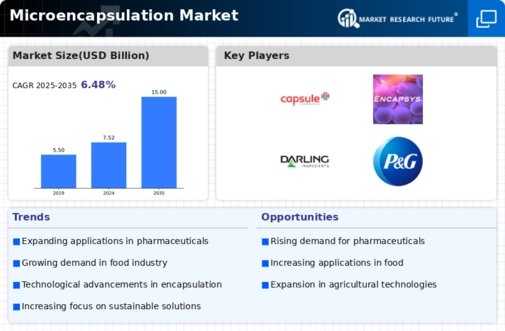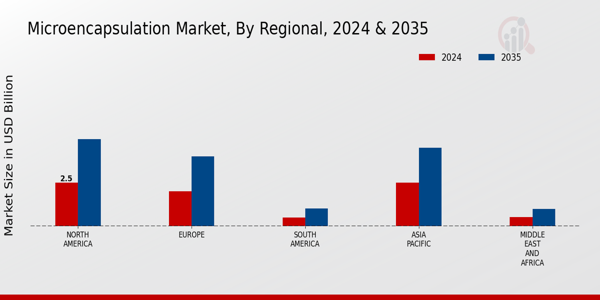Market Growth Projections
The Global Microencapsulation Market Industry is poised for substantial growth, with projections indicating a market value of 7.52 USD Billion in 2024 and a potential increase to 15 USD Billion by 2035. This growth trajectory reflects a compound annual growth rate (CAGR) of 6.48% from 2025 to 2035. The increasing applications of microencapsulation across various sectors, including food, pharmaceuticals, and agriculture, are likely to drive this expansion. As industries continue to innovate and adopt microencapsulation technology, the market is expected to evolve, presenting new opportunities and challenges for stakeholders.
Growth in Agricultural Sector
The Global Microencapsulation Market Industry is witnessing increased adoption of microencapsulation technology in the agricultural sector. This application enhances the delivery of agrochemicals, fertilizers, and pesticides, thereby improving their efficacy and reducing environmental impact. By encapsulating these substances, the release can be controlled, minimizing runoff and maximizing absorption by plants. As the global population continues to rise, the demand for sustainable agricultural practices is expected to grow, potentially driving the market value to 15 USD Billion by 2035. This trend underscores the importance of microencapsulation in promoting efficient resource use and sustainable farming practices.
Regulatory Support and Standards
Regulatory support and the establishment of standards are crucial drivers for the Global Microencapsulation Market Industry. Governments and regulatory bodies are increasingly recognizing the benefits of microencapsulation in various sectors, including food, pharmaceuticals, and agriculture. This recognition fosters innovation and encourages investment in research and development. As regulations evolve to support the safe use of microencapsulated products, the market is likely to benefit from increased consumer trust and acceptance. This supportive regulatory environment may contribute to the anticipated growth of the market, aligning with the overall industry trends towards sustainability and safety.
Rising Demand for Functional Foods
The Global Microencapsulation Market Industry experiences a notable surge in demand for functional foods, driven by increasing consumer awareness regarding health and wellness. As individuals seek products that offer enhanced nutritional benefits, microencapsulation technology provides a solution by protecting sensitive ingredients and ensuring their effective delivery. This trend is reflected in the projected market value of 7.52 USD Billion in 2024, indicating a robust growth trajectory. The incorporation of microencapsulated vitamins, minerals, and probiotics into food products not only enhances their shelf life but also improves consumer acceptance, thereby propelling the industry forward.
Innovations in Personal Care Products
Innovations in personal care products are significantly influencing the Global Microencapsulation Market Industry. The ability to encapsulate active ingredients allows for enhanced stability, controlled release, and improved sensory properties in cosmetics and skincare formulations. As consumers increasingly seek products that deliver long-lasting benefits, microencapsulation technology provides a competitive edge. The market is likely to expand as manufacturers leverage this technology to create innovative formulations that cater to evolving consumer preferences. This trend aligns with the broader growth trajectory of the industry, suggesting a promising future for microencapsulation in personal care applications.
Advancements in Pharmaceutical Applications
In the Global Microencapsulation Market Industry, advancements in pharmaceutical applications play a pivotal role in driving market growth. Microencapsulation technology allows for the controlled release of drugs, improving bioavailability and patient compliance. This is particularly relevant in the development of oral dosage forms where taste masking and stability are crucial. The pharmaceutical sector is projected to significantly contribute to the market, with an anticipated growth rate that aligns with the overall CAGR of 6.48% from 2025 to 2035. As the industry evolves, the integration of microencapsulation in drug delivery systems is likely to enhance therapeutic efficacy and patient outcomes.















